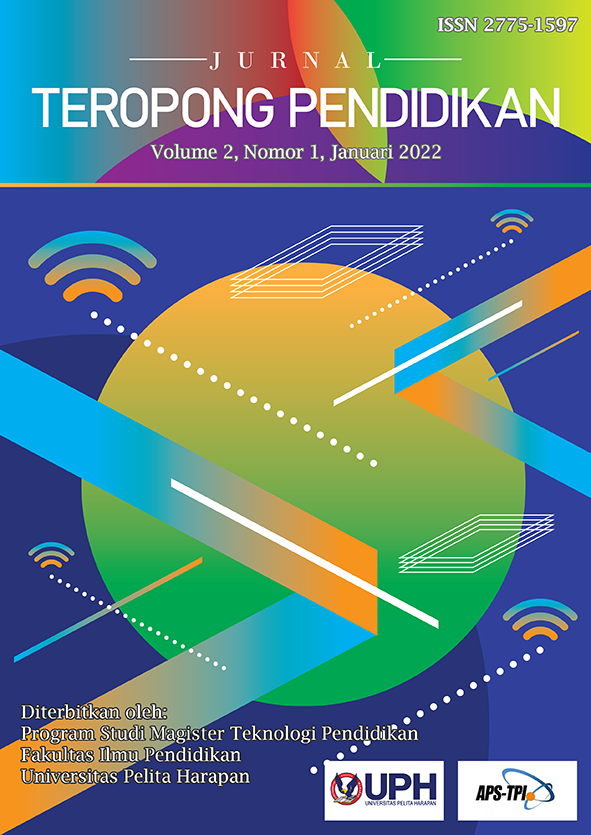Studi Fenomenologi Tentang Pembelajaran Daring pada Anak Usia Dini dalam Masa Pandemi Covid-19 [Phenomenological Study of Online Learning in Early Childhood Education in the Era of Covid-19 Pandemic]
DOI:
https://doi.org/10.19166/jtp.v2i1.4287Trefwoorden:
Online learning, phenomenology, early childhood, digital technology, Covid-19 pandemicSamenvatting
Covid-19 pandemic has had a global impact. One of the steps taken by the Indonesian government as a way to break the chain of the spread of Covid-19 virus is to implement online learning in the education sector. The phenomenon of online learning provides major changes and new habits in the field of education, especially for early childhood education. The purpose of this study is to describe the essence of online learning in early childhood. This research uses a qualitative approach with a phenomenological method to phenomenologically describe online learning. In this phenomenological description, writer describes how online learning is experienced by early childhood and parents. From this research, writer found the essence of the child’s experience regarding the transition to online learning. The results of this study indicate that the transition from offline learning to online learning is a developmental process.
Referenties
Asfi, M. (2017). Metode penelitian kualitatif: Paradigma, metode dan aplikasi. UB Press.
Ghirardini, B. (2011). E-learning methodologies: A guide for designing and developing e-learning courses. Food and Agriculture Organization of the United Nations.
Hardiman, F. B. (2015). Seni memahami hermeneutik dari Schleiermacher sampai Derrida. Kanisius.
Hayes, M., & Whitebeard, D. (2016). ICT in the early years. McGraw Hill.
Heider, K. L., & Jalongo, M. R. (2015). Young children and families in the information age: Application of technology in early childhood. Springer. https://doi.org/10.1007/978-94-017-9184-7
Ihsanuddin. (2020, March 2). Ini pengumuman lengkap Jokowi soal 2 WNI positif Corona. Kompas. https://nasional.kompas.com/read/2020/03/02/12002701/ini-pengumuman-lengkap-jokowi-soal-2-wni-positif-corona
La Kahija, Y. F. (2017). Penelitian fenomenologis: Jalan memahami pengalaman hidup. Kanisius.
Lopato, M. S. (2015). Social media, love, and Sartre’s look of the other: Why online communication is not fulfilling. Philosophy and Technology, 29, 195-210. https://doi.org/10.1007/s13347-015-0207-x
Newland, L. A., Mourlam, D., & Strouse, G. (2018). A phenomenological exploration of the role of digital technology and media in children’s subjective well-being. Child Indicators Research, 11(5), 1563-1583. https://doi.org/10.1007/s12187-017-9498-z
Papalia, D. E., Olds, S. W., & Feldman, R. D. (2010). Human development (Psikologi perkembangan). Kencana Prenada Media Group.
Raco, J. R. (2008). Metode penelitian kualitatif: Jenis, karakteristik dan keunggulannya. PT Grasindo.
Rosenberg, M. J. (2006). Beyond e-learning. Pfeiffer.
Sigelman, C. K., & Rider, E. A. (2010). Life-span human development. Cengage Learning.
Simanihuruk, L., Simarmata, J., Sudirman, A., Hasibuan, M. S., Safitri, M., Sulaiman, O. K., Ramadhani, R., Sahir, S. H. (2019). E-Learning: Implementasi, Strategi dan Inovasinya. Yayasan Kita Menulis.
Sulistyawati, R. L. (2020, March 25). Nadiem jelaskan makna pembelajaran daring. Republika. https://republika.co.id/berita/q7p9wr409/nadiem-jelaskan-makna-pembelajaran-daring.
UNESCO. (n.d.). Early childhood care and education. https://en.unesco.org/themes/early-childhood-care-and-education
Upton, P. (2012). Psikologi perkembangan. Erlangga.
Verbeek, P. (2008). Cyborg intentionality: Rethinking the phenomenology of human-technology relations. Phenomenology and the Cognitive Science, 7(3), 387-395. https://doi.org/10.1007/s11097-008-9099-x
Yusuf, A. M. (2017). Metode penelitian kuantitaif, kualitatif dan penelitian gabungan. Kencana.
##submission.downloads##
Gepubliceerd
Nummer
Sectie
Licentie
Authors who publish with this journal agree to the following terms:
1) Authors retain copyright and grant the journal right of first publication with the work simultaneously licensed under a Creative Commons Attribution License (CC-BY-SA 4.0) that allows others to share the work with an acknowledgement of the work's authorship and initial publication in this journal.
2) Authors are able to enter into separate, additional contractual arrangements for the non-exclusive distribution of the journal's published version of the work (e.g., post it to an institutional repository or publish it in a book), with an acknowledgement of its initial publication in this journal.
3) Authors are permitted and encouraged to post their work online (e.g., in institutional repositories or on their website). The final published PDF should be used and bibliographic details that credit the publication in this journal should be included.





